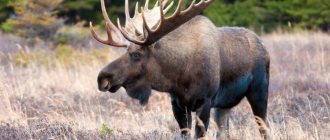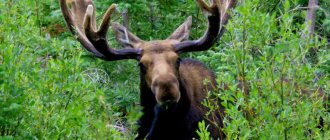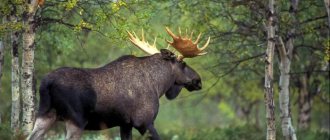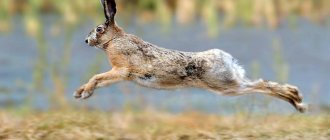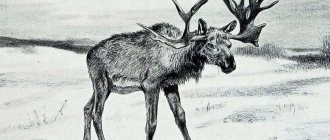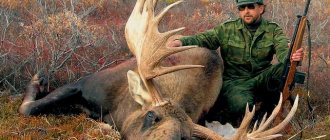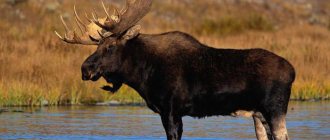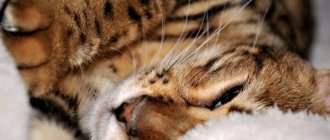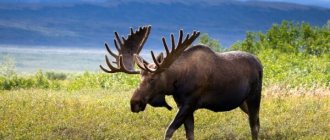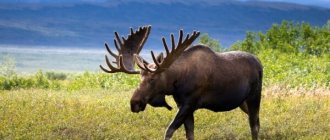- November 26, 2018
- Miscellaneous
- Natalia Egorenkova
Everyone knows what a moose looks like since childhood. Images of the animal adorn the covers of books about nature, city coats of arms, postage stamps and banknotes. The moose has the largest antlers of all representatives of the fauna of the planet; this animal swims, dives well and can sleep in the snow in 40-degree frost. How fast does he run? Looking at the massive beast, it’s hard to believe that the elk’s speed has secured its place among the top fastest animals in the world.
general characteristics
Elks are herbivorous mammals from the order Artiodactyla, the deer family. The height of the male at the withers is from 2.2 to 2.4 meters, the body length from the nose to the tip of the tail can reach up to three meters. An adult male weighs from 400 to 620 kg, a female from 360 to 570 kg. Representatives of the family were discovered in the Far East and Canada, whose body weight was 680 kg.
The general body proportions of the elk differ significantly from the external appearance of other representatives of the deer family.
The body is strong and shortened, the neck is muscular and rather short. On the neck there is a leather pendant “earring” from 25 to 45 cm.
There is a well-defined hump on the back near the withers. The fore and hind limbs are elongated with pronounced joints. The hooves are wide and cloven. The hoof horn is dark brown or black. The hooves on the forelimbs have a pointed edge; this feature helps loosen snow while searching for food and protects itself from predators.
The elk has very powerful legs and a blow with its hoof can cause severe wounds to rivals or predators.
Interestingly, due to the structure of the limbs, the elk cannot reach the ground without spreading its legs. Therefore, an elk nibbling grass is a rather comical sight. To drink, the elk goes into the water or kneels down.
The head is elongated with a wide base. The transition from forehead to muzzle is smooth. The muzzle is massive and slightly widening towards the nose. The nose is soft, fleshy, voluminous and mobile. There is a well-defined hump on the muzzle.
There are no front teeth on the upper jaw. There are 8 incisors on the lower jaw, with the help of which the elk plucks off plant food. There are molars on both the upper and lower jaws; they are used for chewing food.
The body of the animal is covered with dense, coarse hair with a thick undercoat. The fur has different lengths on different parts of the body. In sexually mature males, a beard of coarse hairs forms under the lower lip. The coat color is dark brown or brown-black. Legs are slightly lighter with a grayish tint. There is no tail mirror like deer. Summer color is much darker than winter.
Elena
Ask a Question
Question to the expert
What sounds can moose make?
During the rut, males emit a loud, drawn-out sound that resembles the hoarse sound of a trumpet. During fights, males wheeze and “growl.” Elks usually do not “talk” to each other. Females may "coo" their calves and make quacking sounds during the rut.
Female moose are antlerless.
The size of horns in males depends on age and subspecies. The older the elk, the larger the main part of the antler and the greater the number of branches. Young males remain hornless for up to a year and only by the age of one and a half years they acquire small horny processes. The horn consists of a short trunk (base), a spade (main part) and shoots. The color of the horn is brown to dark brown.
The maximum size of the horns is from 150 to 187 cm, the weight of a pair is from 22 to 34 kg.
Moose, like many deer, shed their antlers after the rut. Depending on the climatic zone, the time of mating games and shedding of old horns may occur in September or November. New antlers begin to grow with the arrival of spring. First, small, soft, knobby growths appear, covered with delicate down. After about 2 months, the horns reach their usual size, the fluff slides off, and the horn becomes ossified. Young horns are called “ponts”.
Before the horns finally ossify, blood vessels and nerve endings pass through them. Therefore, “young” horns are sensitive to mechanical stress, injury and insect bites. If an elk breaks a young horn, it will only be renewed for the next season, and the animal will walk around with the broken horn during the current year.
Question to the expert
Why do moose shed their antlers?
Horns are needed primarily not as protection from predators, but for mating rituals. The larger the horns, the greater the chance of attracting a female and scaring off a rival. After mating games there is no need for horns. After the rut, the amount of hormones in the blood of males rapidly decreases, which leads to the production of cells that destroy bone tissue at the base of the horn.
Moose run very fast and can reach speeds of up to 56 km/h. While running, males throw their heads back to reduce the load from the horns. At such moments, the animals' visibility is significantly reduced, so they can run out onto the road or fall off a cliff. But animals reach maximum speed only during the rut, fleeing from predators or other danger, so this is an exception rather than a characteristic behavior.
Moose are excellent swimmers and can overcome turbulent streams. While searching for underwater food, representatives of the species hold their breath for 1–2 minutes.
Life expectancy in the wild is about 10 years. In captivity, moose can live up to 20 years. This gap is associated with natural selection, since weakened or sick animals become prey to predators or die from hunger and natural disasters.
Who should the moose race with?
Any schoolchild knows that the cheetah is the fastest animal on the planet. Fortunately, the ranges of the big cat and moose do not overlap, otherwise the elk population would be greatly reduced.
Second place in the top fastest animals is occupied by a distant relative of the moose - the pronghorn, which can reach speeds of up to 90 km/h. Next come, again, representatives of the artiodactyl order - Thomson's gazelle with an indicator of 87 km/h and Grant's gazelle (85 km/h).
The fifth and sixth places are shared by the wildebeest and the king of animals - the lion. These animals easily accelerate to 80 km/h. The speed of a moose when running is its legal 75 km/h, putting the elk in an honorable 7th place. It is inferior to the greyhound, hyena dog and brown hare.
Elks do not run around unnecessarily, for the most part they hide in the thicket and are cautious, which further inflames the excitement of the hunters.
Common types
In the wild, there are two varieties: European and American moose. The main difference between the species is the different set of chromosomes. The European representative has 68 chromosomes, the American has 70. Since the difference is not significant and does not prevent hybridization, both species can have common offspring. Because of this, some scientists say there is no need to separate the two species and consider them to be one common species, Alces alces.
European (eastern) elk (Alces alces)
Representatives of the subspecies live in Eastern Europe, the Urals, Scandinavia and the European part of Russia. The height of a mature male is from 210 to 225 cm, body length is from 255 to 275 cm. Body weight is from 598 to 640 kg. Females are usually much smaller, slimmer and leaner. Animal fur in the summer season is much darker than in winter. The main coat color is black-brown, the limbs and muzzle are lighter. The belly, upper part of the muzzle and the inside of the limbs are almost white in winter. The size of the horns is from 100 to 135 cm in span.
Subspecies:
- European elk Alces alces alces;
- Caucasian elk Alces alces caucasicus Vereshchagin.
American (western) elk (Alces americanus)
The American or East Siberian subspecies is slightly smaller than its European relative. Body length from 230 to 250 cm, height at the withers from 190 to 210 cm. Weight of mature adults from 340 to 580 kg. Females are slightly smaller than males. Representatives of the subspecies inhabit the territories of Northern Mongolia, the Far East, Eastern Siberia and North America.
The coat color is uneven. The upper part of the body, withers and neck are gray-brown or dark red, the lower part of the body, including the stomach, limbs from the knee and hock joint are black. The span of the horns is from 70 to 100 cm.
Subspecies:
- eastern Canadian moose Alces americanus;
- Ussuri elk Alces americanus cameloides.
Summary table of moose species according to user ratings
European moose
1
American Moose
0
Where does moose live?
Photo: Elk in the forest
The mammal lives in the forest zone, right up to the tundra. After restoring the almost lost population, it settled again in various types of forests, along overgrown mountains, clearings, raised bogs, and along the banks of reservoirs.
In the summer, the ungulate can go far from the forest, wandering into the steppe or tundra zone. Loves aspen, alder, and clearings with abundant grass.
The animal prefers overgrown oxbow lakes, river channels, and shallow lakes, since in the summer they spend a lot of time in the water or near reservoirs, and loves swimming. It grazes in willow forests, but does not really like the deep taiga. The more diverse the vegetation, the greater the chances of meeting elk here. Mammals in mountainous areas inhabit river valleys, gentle slopes, and do not like very rugged terrain. In the Altai and Sayan Mountains, the vertical range fluctuates 1800-2000 m. The animal can wander into char areas where there are lakes with coastal vegetation.
In swamps, the animal moves to places where the land goes far inland, and then moves along islands, crawling across swampy areas on its belly, with its front legs extended forward. In Altai, they carve out a path in the swamp in dry areas, the depth of which is up to 50 cm. These animals live sedentary lives, staying in one place for a long time if no one bothers them and there is enough food. In summer, an individual plot is larger than a winter one. Ungulates can go beyond the boundaries of their land to salt licks. If there are such places in their areas, then animals visit them in the dark 5-6 times a day.
When the possessions of neighboring individuals intersect, at high densities, the mammals calmly tolerate this and do not expel others, as is the case with most deer families. The exception is moose cows during the first period after calving.
What do moose eat?
Moose are herbivores, so the basis of their diet consists of plant foods. Adult animals and growing moose calves eat grass, lichens, aquatic and semi-aquatic vegetation, as well as bark, berries, young shoots of bushes and trees, pine needles, mushrooms and moss. Typically, the diet of moose depends on the time of year, climate zone and region of residence.
For example, American moose happily eat fir, and the Ural subspecies can eat reindeer moss.
The daily norm for an adult animal is 35 kg in the summer and at least 15 kg in the winter. The annual consumption rate can exceed 7 tons.
Recommended by topic
Fox Panda Lynx
In the summer, artiodactyls feed on the foliage of trees and shrubs, succulent grasses, aquatic plants and young shoots. Their diet includes leaves of rowan, ash, birch, willow, aspen, bird cherry and maple. Animals living near the swamps feast on mosses, watchwort, water lilies, egg capsule, horsetail and marigold. Among herbaceous plants, moose prefer sedge, clover, wheatgrass, plantain, and dandelion. But, in addition to this, they can eat reeds, fireweed, and sorrel. Representatives of the species prefer to graze in burnt-out meadows, where the grass is more succulent and, as a result, nutritious.
Closer to August, the diet becomes more varied. Moose eat ripe berries such as blueberries, lingonberries or cloudberries. They pick up ripe fruits of wild apples, pears, and bird cherry trees, and also eat mushroom caps.
With the arrival of the first cold weather, the animals' diet becomes more coarse. Moose begin to eat young, but not yet woody, shoots of bushes and trees. They do not disdain fallen leaves and dry grass. During this period, the gastrointestinal tract becomes accustomed to wood food.
In winter, moose completely switch to roughage. At this time, they eat bark, grass from under the snow, lichen, pine needles and thin branches. Representatives of the species dine on berry patches and dig up fallen fruits and moss. According to researchers, during the first half of the cold period, moose prefer to eat deciduous trees and shrubs, such as raspberries, rowan, aspen, birch, and fir. And in the second half of winter they give preference to conifers. For example, pine, juniper or fir.
In winter, moose practically do not drink water and do not eat snow. This forced restriction helps animals retain precious heat.
Like many ruminant herbivores, moose require salt. Therefore, representatives of the family constantly visit natural and artificial salt marshes. Animals chew salty soil, drink salted water, and even lick asphalt pavement.
The forage collection period does not have a clear time frame. Feeding and rest periods depend on the time of year and weather conditions. In the summer heat, animals lie down in the shade or go to a pond. In summer, moose begin eating grass at dusk and graze until dawn. In autumn and spring, periods of active search for food alternate with long rest. The animals are not in a hurry, but calmly eat the rich vegetation. In winter, searching for and eating food takes up much of the time, so moose spend all daylight hours in clearings and meadows.
Elena
Ask a Question
Question to the expert
Why do moose eat fly agarics?
Moose, like other animals, eat “poisonous” mushrooms in order to get rid of intestinal parasites. There is a version among hunters that mushrooms eaten in small doses have a positive effect on the tone of males during mating games and battles with rivals.
Daily activity of moose
In autumn, moose can be seen at any time of the day and you must be extremely careful. With the onset of cold weather, they feed during the day, eating branches and pine needles, and at night they rest, plunging into the snow up to the withers. These animals stoically tolerate extremely low temperatures down to -50 °C.
With the arrival of spring, moose continue to lead a diurnal lifestyle, and in the summer heat they become nocturnal animals. Not only the heat, but horseflies and midges drive elk into saving forest reservoirs.
When you get tired of relaxing in shallow water, the animals spend their time usefully: swimming and diving for aquatic vegetation. The speed of the moose during the swim is 2 km/h. And the elk can stay under water for up to 50 seconds.
Sprint races are not typical for moose. He goes into a gallop when he is wounded or frightened. Despite its endurance, a moose cannot run for long, but it is interesting to know who it will defeat in a hypothetical marathon.
Lifestyle and character traits
Representatives of the species inhabit forests, territories bordering the steppe, the banks of swamps, lakes and rivers. In the forest-tundra, animals can be found in aspen or birch groves. Moose occupying steppe areas can move long distances and leave the forest for hundreds of kilometers.
Lifestyle
In areas where the thickness of the snow cover does not exceed 20–40 cm, moose live sedentary. But if the height of the snowdrifts exceeds 70–80 cm, the artiodactyls make long journeys to less snowy areas. Usually, females with calves move ahead of the herd, followed by males and young females without elk calves. This order of movement makes it possible to feed the young animals, since after the adults there is no food left at a height accessible to the kids.
Reservoirs provide animals with additional food and save them from the summer heat. In hot weather, moose enter the water, leaving only their neck and head on the surface. Closer to winter, representatives of the species move deep into the forest, rich in tree and shrub food.
Moose migration occurs gradually and can last several months.
The herd stays for a long time in feeding areas and moves only when the food runs out. A day's journey can exceed a distance of 15 km. With the advent of warming, the herd begins to withdraw and gradually move to its usual areas. The reverse transition takes less time.
Character and habits
Elks lead a sedentary-nomadic lifestyle. If there is sufficient food, small herds can remain in one area all year round. Males prefer to lead a solitary lifestyle, while females with offspring often form small groups.
Forming a herd is a necessary measure.
Small groups of animals find it easier to fend off predators and search for food during the winter. Usually the herd includes an adult sexually mature male and several females with offspring. Closer to summer, the herd breaks up, and the animals can unite again only with the advent of cold weather.
During snowstorms and severe frosts, animals lie down in the snow or look for natural shelter.
Snowfall can completely hide the animals, but they do not feel any discomfort. The air in such mantles is warmed by body heat, and loose snow allows air to circulate. Animals can lie in such a snowdrift for 1–2 days and wait out even the most severe frosts.
Potential victims
The jaguar is a predator whose diet includes at least 85 species of animals living in the same territory. Among the gourmet's favorite delicacies are capybaras, peccary pigs, tapirs, deer, mazamas and even caimans and anacondas. If the hunt for the desired prey is not successful, the jaguar will be content with waterfowl, rodents, and small snakes. Fish occupies an important place in the diet.
Among the potential victims, there is not a single animal that the jaguar could not catch up with. Running speed, cunning and agility are qualities that allow him not to know what hunger is.
Reproduction and raising of offspring
Sexual maturity in moose occurs approximately in the second year of life, but the first mating usually occurs in the third year after birth.
A male rarely covers more than one female per season. But on farms there were cases when one male winged several females, but this behavior is not typical for the natural environment.
Mating season
The rut or mating games begin in September and end in December. The timing may vary depending on the climate zone. During the rutting season, males attract females with a dull, drawn-out roar. This signal also serves to alert opponents.
During the rutting period, moose lose all caution, become aggressive and uncontrollable. At this time, fights occur between males for females, which often end in severe injuries or death of the opponent.
Hunters often find broken antlers in the forest or males that are tightly locked by their horns. If males cannot release their antlers on their own, they will most likely die from hunger and thirst.
Duration of pregnancy and childbirth
Pregnancy lasts from 225 to 240 days. For different females, calving can take place at different times and stretch from April to June. Young females usually give birth to one calf; older females may give birth to twins, but one of the calves usually does not survive.
Elk calves are born with their eyes open and can stand on their feet within a couple of hours.
The body of the newborn is covered with light brown or light red fur. On the third day after birth, babies move freely, try to run and jump.
Females feed their offspring up to 3–4 months, but already in the third week after giving birth, calves try adult food.
The weight of newborns can range from 7 to 15.5 kg; after six months, babies weigh from 50 to 90 kg.
Caring for the Cubs
Females take care of the babies for up to six months. At about four months, they stop feeding their offspring milk and the calves completely switch to adult nutrition. Males do not participate in raising offspring, but if they are in a group, they selflessly protect the babies and their mother.
Grown-up moose calves stay with their mother until spring.
Sometimes young females stay with their mothers for up to two years, and males leave their mother immediately after growing up. During the rutting season, the babies hide and try not to show themselves to adult males, who may regard strangers as competitors for the right to own a female.
Maximum running speed of a hare km/h
As we have become accustomed to since childhood, all hares, or even bunnies, as children call them, are soft, fleecy creatures that jump carelessly on the grass and are scared of everyone until they faint, and therefore everyone strives to offend them. Most likely, we formed this opinion due to watching Soviet cartoons. In fact, everything is far from true. Hares are moderately aggressive and restless creatures that can easily fend for themselves.
Natural enemies
Recommended by topic
Muskrat Flying squirrel Chameleon
In their natural environment, moose do not have many enemies. Only bears, a pack of wolves, a lynx or a wolverine can cope with the mighty artiodactyl. But even in this case, the predator will have to show considerable intelligence. Moose flee for their lives, but if cornered by predators, they use their antlers and sharp front hooves.
A driven elk rests its croup against a natural shelter (tree, rock or bush) and puts its antlers forward. Predators in this situation try to avoid direct contact, since a blow from a hoof can break the skull of an adult bear. Therefore, predators leave dangerous prey and look for other food.
Mostly, old, sick or young animals become prey for predators. Sometimes bears attack pregnant females or drive an adult moose into deep snow or windfall. If a giant gets stuck in the snow or cannot turn around in front of the predator, then he has practically no chance of fighting off.
During the hunt, wolves try to fight off weak individuals from the herd. The pack then chases the animal until it runs out of strength. During the chase, predators bite the elk's hind legs, trying to tear the tendons or draw blood. The giant weakens, falls and becomes easy prey.
But the most dangerous predator at all times has been and remains man. The uncontrolled hunt for horned giants almost led to disaster. The extinction was stopped, but the population of artiodactyls is still under vigilant control, although it has left the risk zone.
Where is the jaguar running?
Let's first figure out why this beast needs to run at all. For example, a wolf is fed by its legs, even first-graders know this. And man is a very mediocre runner, compared to his neighbors on the planet. That’s why he likes to repeat that there is no truth in the legs.
It is impossible to find any information about the jaguar in Russian folklore, but this is not surprising. But if you turn to old Indian tales, you can find very interesting information.
As the legends of the indigenous people of Central and South America say, jaguars can hypnotize (by the way, modern hunters who hunt in those parts also believe in this). And this animal, according to the Indians, skillfully imitates the voice of any of its potential victims.
Scientists, of course, have not found evidence to support any of these versions. However, it is worth paying tribute to the observation skills of the Indians: the jaguar is cunning. This predator prefers to hunt from ambush. It is not surprising that the indigenous inhabitants of the selva accompanied his slowness, ability to wait and cunning with mystical details, and did not glorify the speed of the jaguar. The animal really doesn't like to run.
Continuing to answer the question posed about motives, we note that the jaguar simply has no one to flee from: it is at the top of the food chain and keeps at bay all the large predators sharing its habitat.
Interesting Facts
The behavior of artiodactyl giants is still under study. And although moose lead a fairly understandable lifestyle that is open to research, some aspects of their existence remain in question.
Many interesting facts are associated with unusual representatives of deer:
- Representatives of the species have very poor eyesight. A moose can pass by a person at a distance of several meters. But poor eyesight is more than compensated by sensitive hearing and sense of smell.
- The Swedes process moose droppings and make paper from it. This became possible due to the fact that the litter contains a large amount of cellulose.
- Elk has been a valuable game animal since time immemorial. At the beginning of the 19th century, in some European countries, representatives of the species were on the verge of extinction, and only strict bans on shooting and conservation measures helped preserve the population.
- Russian and Scandinavian farmers tried to domesticate moose, but the animals turned out to be very difficult to maintain, so the idea had to be abandoned. In addition, moose become uncontrollable during the rut, and it is extremely difficult to cope with a giant.
- The speed of the moose is 56 km/h.
- Moose milk is similar in taste to cow's milk. It contains less sugar and more fat. Moose milk is used in dietary and therapeutic nutrition.
- Surprisingly, moose monuments stand in several cities at once. There are sculptures depicting animals in Moscow, Vyborg and Monchegorsk.
- During the Civil War, elk were used as riding animals. Special detachments were formed to quickly advance through swampy and forested areas. There were rumors among the Scandinavians that the Russians had made a deal with the “spirits of the forest.”
- Small moose calves, like foals, can become attached to humans in the first days of their lives. There are known cases of newborn moose calves rescued by humans recognizing their “breadwinner” when meeting in the forest, several years after separation.
- If during pregnancy the female does not have enough food, then the fetus begins to dissolve and nourish the mother’s body.
- Long-legged moose cannot reach the grass, and in order to pick a juicy bunch they are forced to spread their legs wide apart. The kids cannot maintain their balance, and in order to reach the grass, they kneel down, while comically sticking out their loins.
- In order for the moose cow to let the milkmaid come to her, she coats her hands and robe with amniotic fluid, immediately after the calf is born.
Horns and hooves: the main weapon of a moose
In case of danger, the elk can run away. Although it has few natural enemies, even wolves attack only young animals. But sometimes elk have to escape from bears, and then the speed of a running moose reaches 75 km/h. Previously, it was believed that this figure did not exceed 56 km/h.
Moose are hornless, and males rarely use their antlers for defense. The span of the spade-shaped outgrowths in large specimens is 1.8 m, and the weight reaches 30 kg! And this is, rather, not a weapon, but an element of psychological influence on a potential offender. At the end of the mating season, moose shed their antlers, and individuals of both sexes have only one defense - pointed hooves on their front legs.
When going into the forest in the fall, it is important to know not so much the running speed of an elk, but to remember: one blow to the head or torso will cost a person his life. An elk can easily break a skull or rip open a stomach with a sharp hoof. Therefore, it doesn’t hurt to find out where these animals live.
Economic use of elk by humans
Elk are raised on elk farms to produce nutritious and healthy elk milk. Moose are easily tamed. A calf raised by a human becomes completely tame and becomes so attached to its owner that it accompanies him everywhere, like a faithful dog. He can even live in a house, moving quite neatly from room to room.
Tamed moose are excellent vehicles. Some peoples of the North used moose instead of horses. Riding an elk through the taiga is much more convenient than riding a car or a horse, and it feeds itself in the forest.
There were 7 moose farms in the USSR, currently there are two left - the moose farm of the Pechora-Ilych Nature Reserve and the Kostroma moose farm. These experiments are reflected in the film by A. Zguridi “The Tale of the Forest Giant.” Both moose farms are state-owned. Tours are available at the farms.
Moose milk is similar in taste to cow's milk, but is 3-4 times fatter and contains 5 times more proteins. It is used in therapeutic nutrition and for gastrointestinal diseases. During one lactation period - 4 months - a moose cow produces about 500 liters of milk.
Elk meat is inferior in taste to the meat of other deer - it is less fatty and tougher. It is used mainly for the production of canned food and raw smoked sausages.
Nutritional qualities of elk
Elks are a source of two foods at once, meat and milk. Moose cows milk well, their milk is not as sweet as that of cows, but it is fattier. It is used mainly as a special nutritional supplement and for medical purposes. The meat of the animal is tough, it does not contain as much fat as other representatives of cattle. The best option for using meat is to prepare canned meat, stewed meat, corned beef, and raw smoked sausage from it. To prepare various dishes, preparations are taken from young individuals up to 3 years old, preferably females. Their meat is more tender and soft, and is easier to process.
Before preparing the dish, the tenderloin is soaked and marinated for a long time to soften the structure and saturate it with flavor. You can cook excellent soups and broths, bake with herbs, vegetables, fry chops or steaks, stew with mushrooms, potatoes, and vegetables. The taste of elk is also well complemented by sauces made from fresh berries, sweet and fragrant.
Elk meat is a healthy product. The animal is kept in its natural environment, eats environmentally friendly products, and monitors the condition of its body. Meat is rich in fluorine, phosphorus, iron, iodine, sodium, selenium, zinc, and calcium. It also contains a lot of vitamins of the PP group, B 1-2-5-6-12. It is especially useful for sick and weakened people to use it. This way they can quickly regain their strength and get better.
Why is the elk called elk?
In many sources you can find a version that the moose received its nickname due to the similarity of the shape of the horns with the plow - the simplest agricultural tool for plowing the land. In fact, the choice of nickname is related to the etiology of the words “plow” (fork of a tree, fork) and “plow” (branched, forked). In the Old Church Slavonic language, the words elk and horned were practically synonymous and could be used in relation to all animals with horns.
ZEBU
Why do moose eat fly agarics?
Remedies from fly agarics have long been used in folk medicine as an antitumor and antibacterial agent; it was also used to restore tissue and eliminate internal parasites. The reason why moose eat fly agaric mushrooms has not yet been precisely established. According to many researchers, it also lies in certain medicinal properties of the mushroom. It has been established that animals eat only a few fly agarics, which is a very small dose considering the weight of the animal.
Horns
Only males have antlers. Their structure has its own characteristics: a short massive trunk extends from the skull, then it becomes flatter and expands, forming a so-called spade, bordered by small processes. The horns increase every year until the age of 8-10 years, and then, along with the aging processes of the animal, their degradation begins. The maximum weight of elk antlers is 40-45 kg.
When moose shed their antlers
Males shed their antlers before the onset of winter: in late November-early December. In early spring, new shoots form on the animal’s head. Initially, they consist of cartilage tissue, are covered with skin and contain many nourishing blood vessels. By summer, the antlers ossify and become hard and durable.
How to determine the age of a moose by its antlers
You can determine the age of a male by looking at his horns as follows:
- determine the number of processes: in the awls (two-year-old males) there is only one process, then their number increases;
- measure the thickness of the horn barrel at the rosette.
The method is not accurate, since the size and shape of the horns are influenced by the condition of the animal, the availability of food supply and some other factors.
